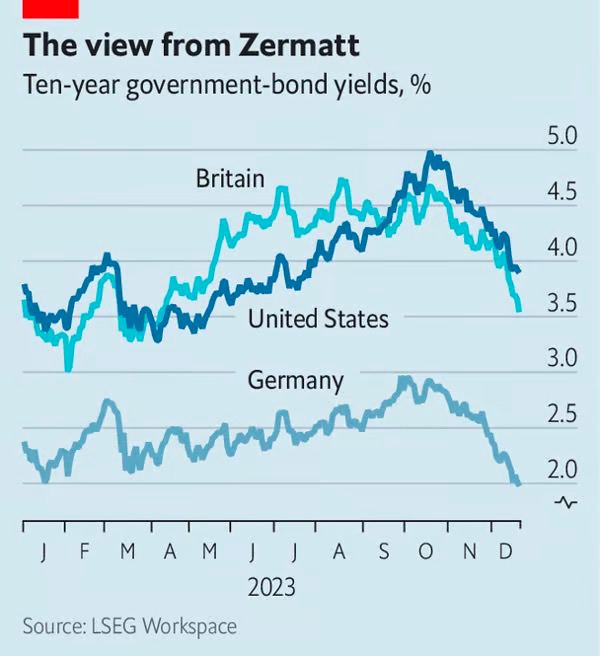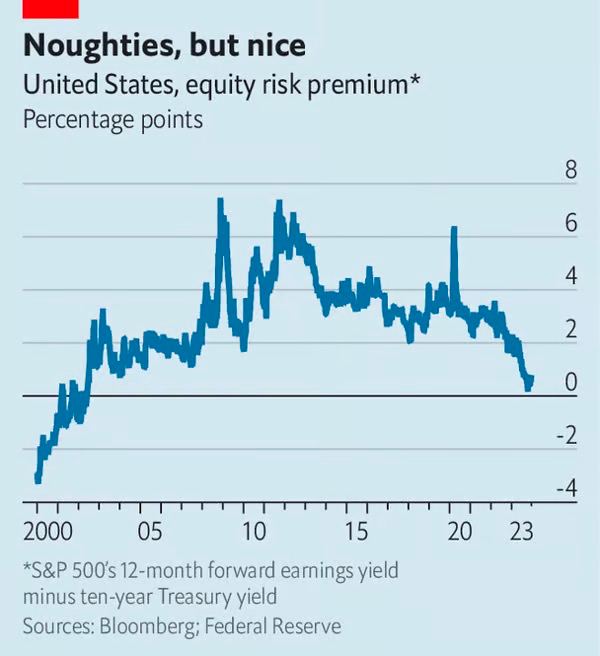Shareholders have had a remarkably good year. Forecasters have had a terrible one
Financial markets will always produce surprises. After all, by the time a consensus has formed, people will have bought or sold accordingly. The move has already happened; the future has something else in store.
Even accounting for this, investors have had an unusually difficult time in 2023. The year started with broad agreement that 2022’s soaring interest rates would cause recessions in much of the world. Not only was this baked into asset prices—it also turned out to be wrong.
Yet it was not just economic assumptions that were overturned. Here are the other big market surprises of 2023.
Rates went higher. And bond yields rose by even more…
The year began with the Federal Reserve’s credibility in question. Rate-setting officials had spent nine months tightening monetary policy each time they met. Jerome Powell, their chairman, took every opportunity to make hawkish noises. The market was not buying it, however, expecting that the central bank would relent and start cutting within a matter of months, before it accidentally broke something.
That “something” turned out to be a clutch of American regional banks, the first of which—Silicon Valley Bank—collapsed in March. By continuing to raise rates even amid the turmoil, the Fed at last convinced investors that it was serious. The market accepted officials’ projections for where their benchmark rate would finish the year, whereas longer-term yields on government bonds marched ever higher. Ten-year American Treasuries, which hit a low of 3.2% in April, breached 5% in October, their highest since 2007. “Higher for longer” became the market’s mantra. Huw Pill of the Bank of England compared the future path of rates to Cape Town’s flat-topped Table Mountain, contrasting it with the triangular Matterhorn.
…until both reversed course harder than anyone expected
Within weeks of Mr Pill’s comments, yields had begun a distinctly Matterhorn-like descent (see chart). Those on ten-year American, British and German government debt are now around a percentage point below their peaks—amounting to a party in the bond market, since prices rise as yields fall. The festive mood took hold as one data release after another spurred hopes that inflation was fading and central bankers might not need to be so hawkish after all.

Once upon a time, this would have prompted a rebuttal from Mr Powell, anxious that falling borrowing costs might stimulate the economy and undo his inflation-fighting work. Instead, the Fed’s chairman spiked the partygoers’ punch. On December 13th he announced that officials were already discussing rate cuts, which he envisaged taking place “well before” inflation hit its target of 2%. Bond investors turned the music up a notch.
Other markets shrugged off the interest-rate ructions
Few things matter more to the financial system than the “safe” yields available on government bonds and their implications for everyone else’s borrowing costs. So the wide swings in these yields throughout the year might have been expected to leave all sorts of asset classes looking wobbly. Instead, most showed remarkable resilience.
Investors had worried that rising interest rates might leave indebted borrowers unable to meet obligations. Yet after two years of such increases, the annual default rate on the riskiest “high-yield” American bonds was just 3.8%—below its long-term average of 4.5% and nowhere near peaks reached during crisis years such as 2009 or 2020. Investors in such debt therefore had an excellent year, with Bank of America’s high-yield index returning 13%.
The story in other supposedly rate-sensitive markets was similar. Global house prices began to climb again after only the briefest of blips. Gold rose by 12%. Even bitcoin—the poster-child of the cheap-money era—soared.
America’s stockmarket got high on artificial intelligence
The recovery of America’s stockmarket was less spectacular than that of bitcoin, but in some ways more surprising. Having fallen by 19% over the course of 2022, the s&p 500 share index has clawed back nearly all of its losses, returning to within touching distance of its all-time peak.
Two aspects of this recovery have taken many investors aback. The first is that, despite their previous losses, American stocks started the year looking pricey and then became much pricier. Measured by the excess return expected from their earnings, over and above the “risk-free” yield on government bonds, they are now more expensive (and hence yield less) than at any time since the swelling of the dotcom bubble (see chart).

The second aspect is that this exuberance—essentially an assumption that shares have grown less risky and earnings growth more assured—took place amid a mania for ai. America’s tech giants provided the lion’s share of the gains, with investors judging them best placed to benefit from the new technology. Profits to be made from novel and yet-to-be-commercialised inventions are inherently uncertain. Nevertheless, equity investors are going all in on them.
IPO bankers are still at a loose end
Sadly, not everyone is feeling bullish. The market for initial public offerings remains moribund. Dealogic, a data firm, estimates that companies going public raised some $120bn globally in 2023. That is less than the $170bn raised in 2022 and a fraction of the amount raised in 2021, of more than $600bn. The high-profile firms that did go public—including Arm, a chip designer, and Instacart, a grocery-delivery group—failed to spark a broader revival.
Confusion over where long-term interest rates will settle did not help. But in other respects the dearth of new listings is a puzzle. Volatility has fallen, economic headwinds have died down and equity investors are throwing caution to the wind. That private firms are cautious might mean they see reasons to worry which the rest of the market is missing. Or perhaps they are merely getting ready to join the party in 2024. After months of twiddling their thumbs, bankers will be hoping for the latter.








